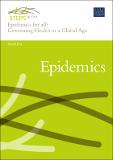| dc.contributor.author | Dry, Sarah | |
| dc.date.accessioned | 2013-03-08T11:09:55Z | |
| dc.date.available | 2013-03-08T11:09:55Z | |
| dc.date.issued | 2008 | |
| dc.identifier.citation | Dry, S. (2008) Epidemics for all? Governing Health in a Global Age, STEPS Working Paper 9, Brighton: STEPS Centre | en_GB |
| dc.identifier.isbn | 9781858645433 | |
| dc.identifier.uri | https://opendocs.ids.ac.uk/opendocs/handle/20.500.12413/2467 | |
| dc.description.abstract | Current global health policy is dominated by a preoccupation with infectious diseases and in particular with emerging or re-emerging infectious diseases that threaten to ‘break out’ of established patterns of prevalence or virulence into new areas and new victims. This paper seeks to link a set of dominant narratives about epidemics and infectious disease with what is often called the
architecture, or organizational landscape, of global health policy. A series of dichotomies helps to distinguish and valorise epidemics policies. Fast- versus slow-twitch models of disease, global versus local models of culture, and official versus unofficial models of knowledge provide categories according to which policies can be evaluated, designed and implemented. As a result, policy on the global scale has tended to be oriented towards addressing highly time-focussed outbreaks that threaten to cross international boundaries rather than longer-term endemic problems the affect the most vulnerable people. Failure to address such long-term changes may make the whole global system itself more vulnerable over time. Recent changes in the organizational landscape of global health have created new power relations, as well as uncertainty about which organizations, if any, are ‘in control’ of global health policy. In addition, the WHO’s revised International Health Regulations, fully implemented in 2007, entail significant changes for way epidemics are governed at a global scale, embracing unofficial sources of information for the first time. Issues of coordination, integration and harmonization have accordingly come to the fore.
This paper will analyze how this new organizational landscape and the framing of epidemic disease interact. Centrally, it will explore what effect that interaction has on the ability of the global health community to respond to disease threats of all kinds. It will argue that neither organizational complexity or ‘openness’ nor rigid lines of command-and-control can ensure resilience in the face of unpredictable risks. Instead, methods are needed to encourage feedback and integration between competing narratives of health and diseas | en_GB |
| dc.description.sponsorship | ESRC | en_GB |
| dc.language.iso | en | en_GB |
| dc.publisher | STEPS Centre | en_GB |
| dc.relation.ispartofseries | STEPS Working Paper;No.9 | |
| dc.rights.uri | http://creativecommons.org/licenses/by-nc-nd/3.0/ | en_GB |
| dc.subject | Globalisation | en_GB |
| dc.subject | Governance | en_GB |
| dc.subject | Health | en_GB |
| dc.title | Epidemics for all? Governing Health in a Global Age | en_GB |
| dc.type | Series paper (IDS) | en_GB |
| dc.rights.holder | STEPS Centre | en_GB |
| dc.identifier.externaluri | http://steps-centre.org/publication/epidemics-for-all-governing-health-in-a-global-age/ | en_GB |
| dc.identifier.koha | 184117 | |


